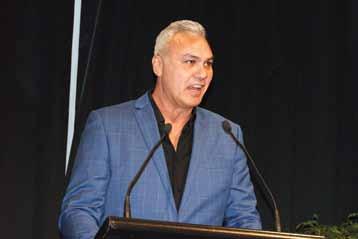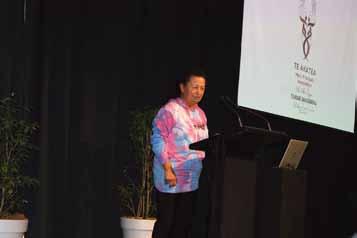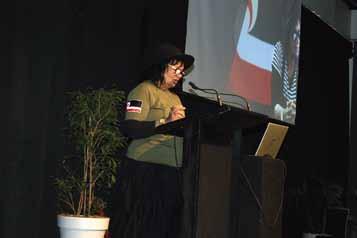
7 minute read
con FE r E nc E with t E a K at E a
Liz hawes Editor
NOWhErE FEELS aS warm and welcoming as an Akatea conference. It begins with the pōwhiri and continues for the duration. This year, conference was held at the Vodafone Events Centre in Manukau City, South Auckland. You know this place is special when you are greeted by the 70 feet tall kauri Pou Kapūa Taonga, alongside which are two 3-metre high moai –Easter Island figures. The Pou Kapūa is described as ‘a gift from Māori and all New Zealanders to the world’ and incorporates not just Māori symbolism and stories, but also Polynesian creation beliefs and legends and stories of migration to Aotearoa New Zealand. Indigenous carvers from Alaska and Saskatchewan were also invited to contribute, carving their ancestors onto this brightly coloured pou. It is a superb piece of art and even more beautiful because of its inclusiveness. Organisers had staged the conference space in the style of a bygone Pā site, complete with fern fronds, flaxes and palisades to frame the exhibitors and sponsors, and to mark out the stage area, from where the energetic performances of Ākonga from Kia Aroha College rang out. But it’s not just the place that makes the conference so special, it’s the people. Māori have a whakatauki (proverb) to express this sentiment. He aha te mea nui o te ao? He tangata, he tangata, he tangata! ‘What is the most important thing in the world? It is people, it is people, it is people’. This proverb, linked to the concepts of whānaungatanga and manaakitanga, becomes real and natural when you gather with Akatea principals. Whether singing a waiata, learning an action song, listening to speakers, or in a break, randomly enjoying beautiful saxaphonic tunes played by Damon Ritai, you are included, and connected. You are part of the whole. This feeling is even more poignant when the theme of almost every presenter involves the notion of ‘collectivism’. The whole is so much greater than the individual parts.

The theme of collective power was made clear in President, Bruce Jepsen’s, opening speech.
‘Te Akatea emerged in the 1990s from collective dreams,’ he said, before quoting Princess Te Puea Hērangi –

‘Mehemea ka moemoeā ahau, ko ahau anake. Mehemea ka moemoeā tātou, ka taea e tātou.’
‘If I dream, I dream alone. If we dream as a collective, we can achieve our dream.’
He talked about the evolution of Te Akatea over the years, how it has strengthened its voice and developed more ambitious dreams, like shifting inequities. ‘Our perspective is valued by the Ministry of Education now,’ he said, ‘and that creates more opportunities for us.’ He used the Aotearoa New Zealand Histories curriculum as an example of how the Māori voice has had influence and the contracts that Te Akatea has won as a PLD provider for Māori leadership, including the new ‘Emerging Māori Leaders Programme’, the ‘Māori First Time
Principals’ Programme’ and the well-known and respected Māori Achievement Collaborations (MACs).

His pledge was to, ‘ . . . work with mana whenua, hāpu and iwi to bring their collective dreams to reality.’ This, he said, will require a transformational review of the Akatea constitution so that it reflects our intentions in 2023. That includes taking account of the United Nations Declaration on the Rights of Indigenous Peoples to control their educational systems and institutions, and assertion of tangata whenua rights. ‘It is all about increasing the power of the Māori collective,’ he said.
He concluded by acknowledging all the former presidents of Te Akatea since 1990 and the contributions each has made. ‘We have all been fighting the same struggle,’ he said.
Kiritina Johnstone, the Te Reo Māori Group Manager for the Ministry, updated Tumuaki on the redesign of Te Marautanga O Aotearoa – the New Zealand Curriculum that stems from a Māori world view and has an unconditional commitment to ākonga and whānau. Ākonga, she said, carry ancestral legacies through their whakapapa and it’s our job to support them to know their whakapapa, so they can contribute to their whānau, hapū and iwi and be the link between past, present and future. There are things to be fixed, she said, including inequities, bias and racism.
She outlined the four pou supporting the Te Marautanga Curriculum that must come to life, including equity, trust and cohesion. ‘We must build this into our system, she said. The Ministry can do so much then we need you to help us,’ she said. ‘It’s easy to change the policy, but the challenge is getting the backing for that policy.’ She encouraged
Te Akatea representatives to speak out in Ministry meetings and remind those present that equity, trust and cohesion are not yet a reality. She also encouraged members to network with each other, ‘because it makes us stronger’.

She drew attention to the national framework, Te Tirewa, that is consistent with the principles and values of Te Ao Māori and which Tumuaki can personalize. ‘You have policy guidelines on the national curriculum that you don’t leave to chance,’ she said, ‘but other learning can be agreed with whānau, iwi and hapū.’

‘To implement Te Marautanga, we need the workforce and at present we do not have it, so we must shift the workforce we do have,’ she said.
She introduced many curriculum resources that tumuaki can access easily, including Te Ara Pūoro a Māori pedagogical system for teaching music. Most importantly though, she emphasized the collective input, ‘We can’t just change the words in a book. We need to hear what you want, what your communities want and what your barriers are.’
Bronwyn Williams (Psychologist) and Rikki Solomon delivered a strong message about how to deal with racism. ‘Knowing makes no difference, it’s disrupting, applying your knowledge, interrupting, transforming the spaces we live in,’ they said. ‘Working together we can make the difference.’ They noted three major failures in education. Individualism, rather than working together to answer problems; meritocracy, or competition which leads to winners and losers about who holds selective knowledge while undervaluing other knowledge; and a history where indigenous history is not valued or told. They encouraged the collective to change their thinking so that ‘we are thinking always from an indigenous world view’. Hilda Harawira brought a message of liberation to the conference. Well known as a bold and fearless woman, unafraid to fight for her beliefs, Hilda has had a colourful history in defending the rights of Māori people and calling out racism and Te Tiriti o Waitangi breaches whenever they occur. Hilda was in the vanguard of the 1970s pushing through to the Māori renaissance of the 1980s and beyond. She and husband Hone, became a formidable force for activism, fighting racism and Māori oppression. Liberation is synonymous with tino rangatiratanga for Hilda and should not be a distant destination. Former principal of Te Wānanga o Te Rangi Āniwaniwa (Kura
Kaupapa Māori), Hilda was determined that the struggles for resources and recognition of what is of value to Māori education must end and she called for an Independent Māori Education Authority.



‘We are sick of waiting for nothing to happen,’ she said.
Dr Hana O’Regan, academic and Māori language advocate, attacked the narrative that has kept Māori at the bottom of every social, health and educational statistic for too long. She invited the audience to name the things that define the Kiwi identity and those that define Māori. Kiwi identity was seen as positive, high achieving, successful. Māori identifiers included playing the guitar, prison, school exclusions, gangs, domestic violence, lazy, good at sport and singing, under-achievers. ‘If you are Māori, this is you by age 3. What is there for you if you can’t play guitar, sing or be good at sport?’ she asked. She acknowledged that incremental change has occurred like Kohanga Reo and Kura Kaupapa Māori options for education, but the narrative has not significantly changed. We still hear it, she said ‘My Māori students are at or just above standard. They’re average so that’s OK.’ And the stereotypes endure. ‘If we don’t name it and amplify an alternative narrative this will continue,’ she said. ‘Work collectively,’ she encouraged her audience.

Linda Munn, in 1989 responded to the call of Hilda Harawira

She took her audience through the various articles of Te Tiriti o Waitangi, pointing out how Māori of the time interpreted the different articles and how they were intended by Pakeha. The differences were monumental. Constitutional transformation was her suggestion for addressing these inconsistencies.
Hoana Pearson, Head coordinator of Te Ara Hou, Māori Achievement Collaboratives (MACs) had the final say of the conference. Stepping out of the comfort zone every day, was her message. That’s what MACs are about. The programme is about identity and whakapapa and changing hearts and minds. It is about leading and supporting principals, in collaborative to design a flag to unify Māori concerns as the 1990 celebrations, commemorating 150 years of Māori and Pakeha relations, approached. Together with Hiraina Marsden and Jan Dobson, she designed the Tino Rangatiratanga flag, now mandated as the national Māori flag and symbol of Māori resistance, revitalisation and restoration. Her message was one of unification and collective voice and claiming the values embedded in Tino Rangatiratanga. groups, through a process of examining their own world view and critiquing that with the help of trained facilitators. Once they do that, they can appreciate a different world view, a Māori world view. It is about school leaders breaking down the barriers of racism and bias in their schools. The programme began with 47 courageous principals, she said, and today involves 432 with a waitlist of 32. The demand is huge because of the credibility and integrity of the mahi we do – a reputation we are proud of, she said.
Dr Veronica Tawhai, Deputy Vice-Chancellor Māori at Massey University, gave a potted history of colonisation to show how stereotypes were embedded with Māori expected to fulfil the role of manual labour for the nation. Extermination of Māori was the agenda in the 1860s, but that was not attainable so instead, Native Schools were introduced which prevented the teaching of academic studies. Māori were referred to as the ‘savage race’ in parliamentary debates.
Reflecting on the three-day conference, it can best be summed up in the following whakatauki:


Ehara taku toa, i tee toa takitahi, engari he toa takitini
My success should not be bestowed onto me alone, as it was not individual success but success of a collective.







